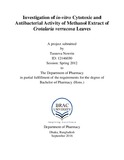| dc.contributor.advisor | Akter, Dr. Raushanara | |
| dc.contributor.author | Nowrin, Tasnova | |
| dc.date.accessioned | 2017-07-23T07:17:28Z | |
| dc.date.available | 2017-07-23T07:17:28Z | |
| dc.date.copyright | 2016 | |
| dc.date.issued | 2016-09 | |
| dc.identifier.other | ID 12146030 | |
| dc.identifier.uri | http://hdl.handle.net/10361/8338 | |
| dc.description | This project report is submitted in partial fulfillment of the requirements for the degree of Bachelor of Pharmacy, 2016. | en_US |
| dc.description | Cataloged from PDF version of project report. | |
| dc.description | Includes bibliographical references (page 44-45). | |
| dc.description.abstract | Crotalaria verrucosa(C. verrucosa) has been traditionally used as a medicinal plant in Bangladesh for treating inflammation, skin diseases as well as heart diseases etc. Extracts of the various parts of this plant also possess therapeutic effects such as antipyretic, anti-diabetic, CNS depressant, antifertility and many more. Leaf extract of this plant contains alkaloids, flavonoids, glycosides, tannins, phytosterols, steroids and resins. The objective of this study was to evaluate In vitro cytotoxic and antibacterial activity of methanol extract of this plant. In this study, cytotoxic activity study was performed by MTT assay at different concentrations (2.5 mg/mL, 0.25 mg/mL, 0.025 mg/mL, and 0.0025 mg/mL) of plant extract to determine its cytotoxic effect using HeLa cell line. The cytotoxicity test revealed that the highest cell growth inhibition (93.2%) was shown at the highest concentration of 2.5mg/mL of this methanol extract whereas the lowest cell growth inhibition was shown at the two lowest concentrations of 0.0025 mg/mL and 0.025 mg/mL extract of this plant. The IC50 value of C. verrucosa methanol extract was 0.83 mg/mL. This test finding showed that the cell growth inhibition was concentration dependent. With increasing concentration of plant extract, cytotoxic activity also increases gradually. The antibacterial activity of this plant extract was determined by disc diffusion method against 3 bacterial strains such as, Bacillus cereus, Streptococcus pneumoniae and Shigella dycenteriae.A standard antibacterial drug, Kanamycin was used. The inhibitory zones were recorded in millimeters. The highest concentration 350 μg/disc of this plant extract showed a significant result against Bacillus cereus and the zone of inhibition was 17 mm whether kanamycin showed an inhibiting zone of 31mm. The leaf extract contains alkaloids, flavonoid, glycosides and tannins which may exhibit the potential cytotoxic and antibacterial activity in this experiment.These findings indicate the possibility of using traditional plant extracts in the treatment of bacterial infections as well as in cancer treatment and the results of this study was encouraging, to be sure the need for pre-clinical and clinical studies to determine of the real effectiveness and potential toxic effects. | en_US |
| dc.description.statementofresponsibility | Tasnova Nowrin | |
| dc.format.extent | 45 pages | |
| dc.language.iso | en | en_US |
| dc.publisher | BRAC Univeristy | en_US |
| dc.rights | BRAC University project report are protected by copyright. They may be viewed from this source for any purpose, but reproduction or distribution in any format is prohibited without written permission. | |
| dc.subject | Crotalaria verrucosa | en_US |
| dc.subject | In-vitro | en_US |
| dc.subject | Antibacteria | en_US |
| dc.title | Investigation of in-vitro cytotoxic and antibacterial activity of methanol extract of Crotalaria verrucosa leaves | en_US |
| dc.type | Project report | en_US |
| dc.contributor.department | Department of Pharmacy, BRAC University | |
| dc.description.degree | B. Pharmacy | |

